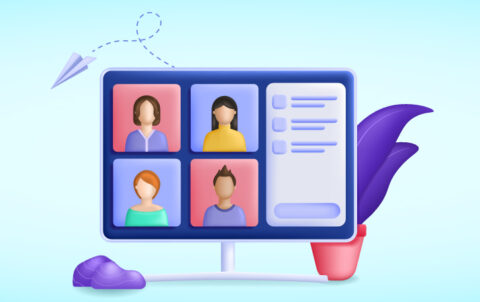© 2025 Next Level Business Services Inc. All Rights Reserved.
Benefits of Remote Working (Work from Home)
By NLB Services
What is Remote Work?
The remote work model is a professional environment where employees can work from home or anywhere away/outside of the office. Sometimes it involves creating a workspace at home or at an outstation. Working remotely can be extended beyond the confines of office space or living space, which makes it a popular option for “digital nomads” who have to spend most of their time traveling full-time. Not limited to the home office setups, remote work is often undertaken from hotels, cafes, co-working spaces, etc. Previously, working remotely was a challenge because of technology and resource constraints. But now, collaboration tools like Slack, Zoom and Wrike have helped bridge that technology gap and enabled people to work remotely and connect on the go.
Top 6 Benefits of Remote Working for Employees
1. Better Work-Life Balance
Poor work-life balance impacts workers health and happiness negatively. They tend to become more stressed and feel less in control of their work and personal lives. People who have a good work-life balance are often less stressed and happier. When you are happier, you become more motivated and productive. That is the main reason why people prefer remote work. Employees feel more relaxed and work productively in remote work to get tasks done efficiently, and make time for outside activities and not just work.
2. Less Commute Stress
Remote work has proved to be cost-efficient for both employers and employees. While bringing down business operation costs, it has saved commuting costs for employees. Many companies are shedding expensive downtown office spaces and adopting a remote work model. Since the employees get the liberty to carry on their work without commuting to any specific place, they end up saving both time and money.
3. More time with loved ones
Flexible work allows you to give your family the valuable time they deserve. Flexible work from home models help employees support their families more efficiently. For some, remote work sounds like a perfect work arrangement as they get a chance to make up for lost time and moments with their parents, spouses, children and so on.
4. Money Savings
Working from home saves money and time. Time spent in line waiting for the office elevator, time looking for a parking slot so you can get on the train, time and money spent shopping for work clothes, and commuting on buses or other means of transport. N number of costs are involved while working from the office and commuting. Working from home helps in saving thousands spent on traveling or transportation (gas, car maintenance, public transport pass, etc.). Other spending like coffee, lunch, professional outfits attire and dry cleaning become secondary during work from remote. It not only helps one eliminate unnecessary expenses but also improves employees’ overall well-being and health.
5. Flexible hours
Remote work often comes with flexible work hours, allowing workers to set their own time to work during their peak productivity hours. This not only helps employees deliver quality work but also considers their comfort and availability.
6. The ability to live where you want to
The beauty of a remote work set-up is that you are not obliged to work from a specific location and get a chance to take your work anywhere (as per the company’s policy). Be it any part of the world, your couch, a coffee shop, or poolside, as long as you have a strong internet connection.
Top 7 Benefits of Remote Working for Employers
1. Higher Productivity
As reducing absenteeism is the priority, having a team that works remotely helps make the workforce healthier and happier. There are numerous contributing factors, such as better health due to healthy food and fitness habits that enable one to lower their time off due to diseases or illnesses. Other than that, eliminating the commute to work saves time and gives you mental peace. It also means extra time to go to bed and have a quality sleep. It optimizes mental health and the immune system. Healthier employees are happier, more productive, and less likely to take medical leave.
2. Greatly Expanded Talent Pools
An often-overlooked benefit of remote working is the geography-agnostic approach to work. During work from home, companies have the ability to expand their talent search and onboard the most qualified people for the job, regardless of where they live. The onsite work barriers no longer apply to a remote work scenario and hiring managers to get a chance to boost their talent pool by going beyond geographical borders.
3. Reduced Office Expenses
Many companies allow employees to use their own laptops and smartphones, which significantly reduces costs. The drain on resources like paper will tend to decline. Moreover, it also helps businesses cut down on the costs for workstations, stationery items, etc. Providing employees with equipment in an office can be expensive. After all, investing in computers, printers, photocopiers, paper, work desks, chairs, installation of the coffee machine, and other items required daily comes with a considerable cost. This spending can be avoided or eliminated when remote work is on offer.
4. Reduced Carbon Footprint
A study found that remote work would reduce the amount of nitrogen dioxide (the primary pollutant generated by traffic emissions) by around 10%. Harmful gas emission due to onsite work is determined by factors like whether employees use public or private transportation, how far they travel, and their commercial and residential electricity usage patterns. For example, working from home doesn’t involve driving which ultimately helps in reducing greenhouse gas emissions. Fewer people commuting to work equates to lesser pollution.
5. Improved Inclusivity
In remote work, employees are less likely to meet face-to-face. An inclusive environment cannot be achieved solely through systemic efforts but also through the behavior of peers and leaders who make conscious inclusion in their daily practice. An inclusive work environment leads to better outcomes and supports the foundational business goals of an organization. Hiring for remote work opportunities enables companies to expand diversity and inclusion within the company by hiring people from different socioeconomic, geographic, and cultural backgrounds. It helps employees to meet people from different places/countries and helps to build a diverse network. A distributed workforce allows employees to work from home and remain supportive throughout.
6. Better Emergency Preparedness
Emergencies can occur anytime. The global pandemic has demonstrated the importance of emergencies and how to be well prepared for the same. When companies adopted remote work opportunities, it helped to control the disease getting spread, and also made employees feel relaxed and rejuvenated.
7. Happier and Healthier Employees
Employees look for jobs that offer more freedom, flexibility, and a better work/life balance. As per a survey, remote workers say they are likely to stay in their current jobs for the next five years – 13% more than on-site workers. Offering remote work opportunities to employees makes them happy as compared to on-site work. If you want your employees to be happier, it’s time to consider remote work wherever possible. Working remotely makes them more focused, engaged, and motivated to do their jobs well and more satisfied with their work.
Conclusion
Regarding the overall remote work opportunity, employers should be mindful of maintaining a workplace culture and making it a priority no matter where the employee is located and working from. Several tools and transparent custom workflows help remote workers manage their duties, keep them connected, and feel valued even when they are working from other locations.
Advantages of Working From HomeCareer GrowthRemote WorkingWork and Life BalanceWork From Home Benefits
Talent Solutions








